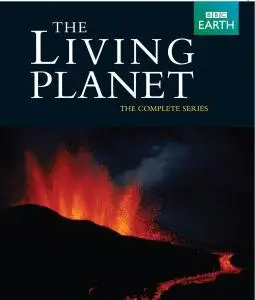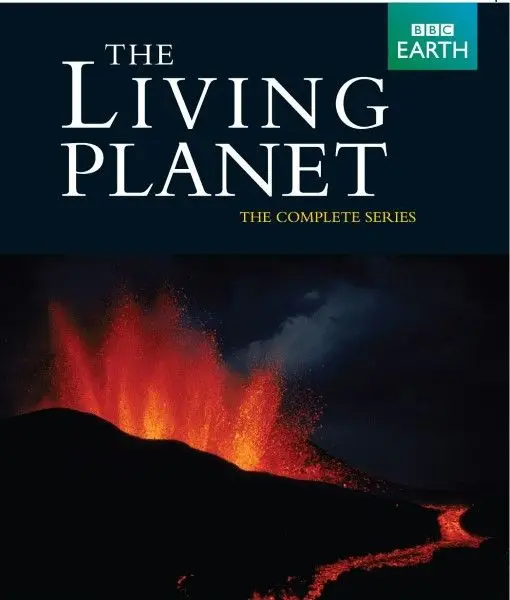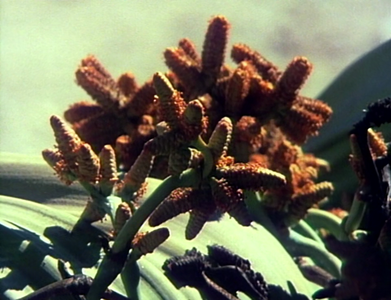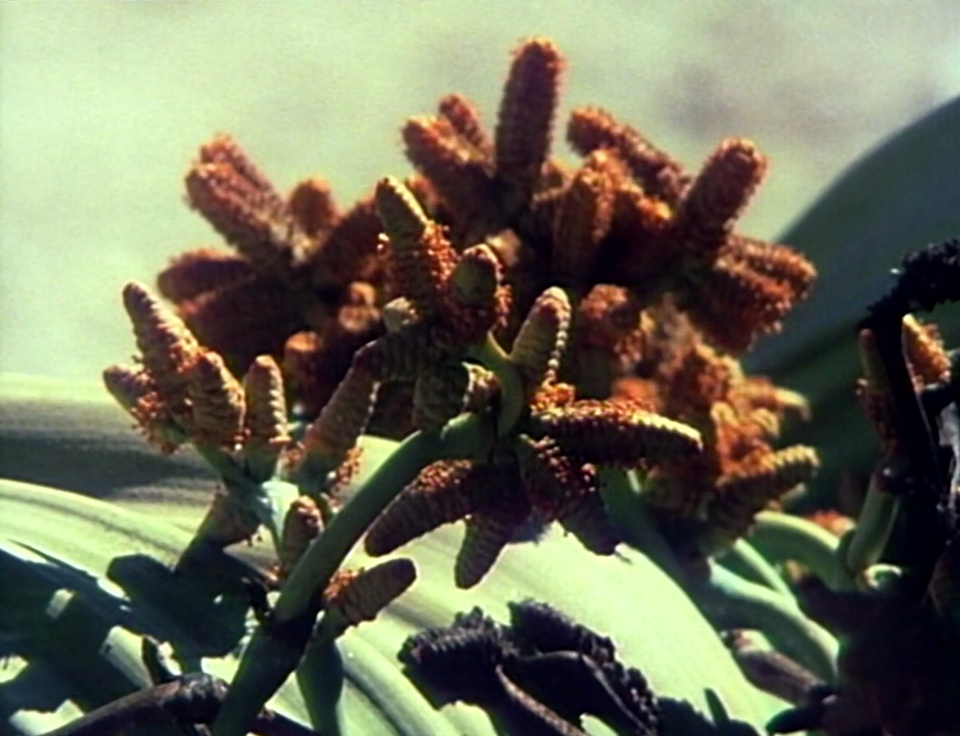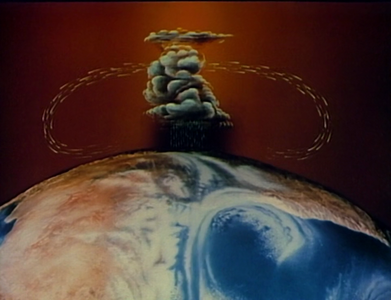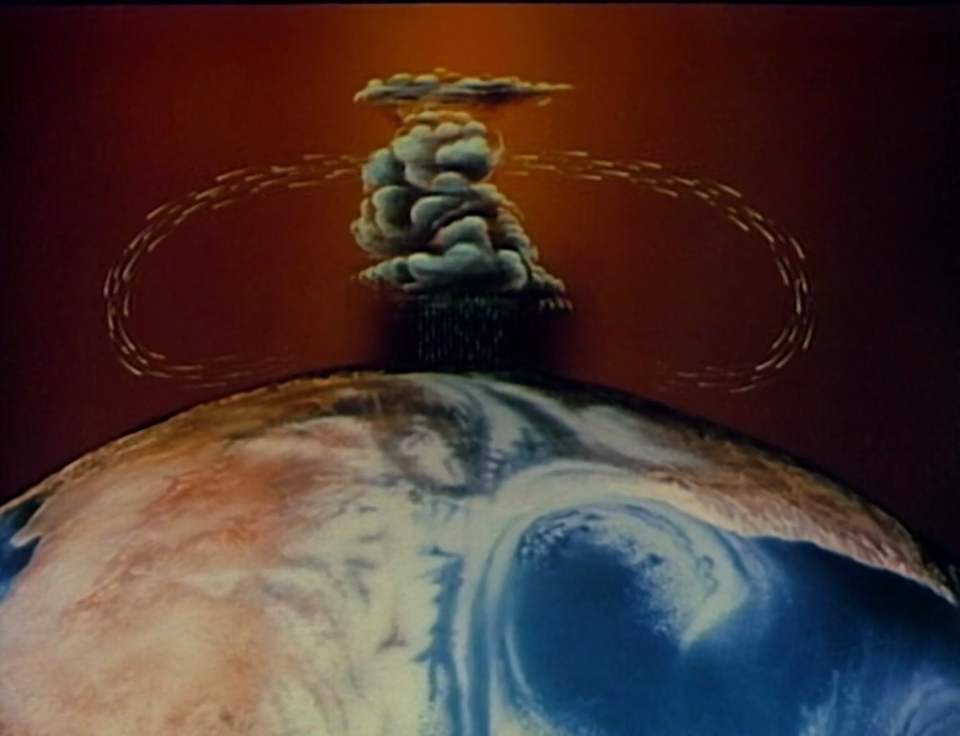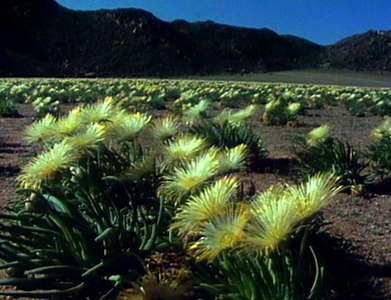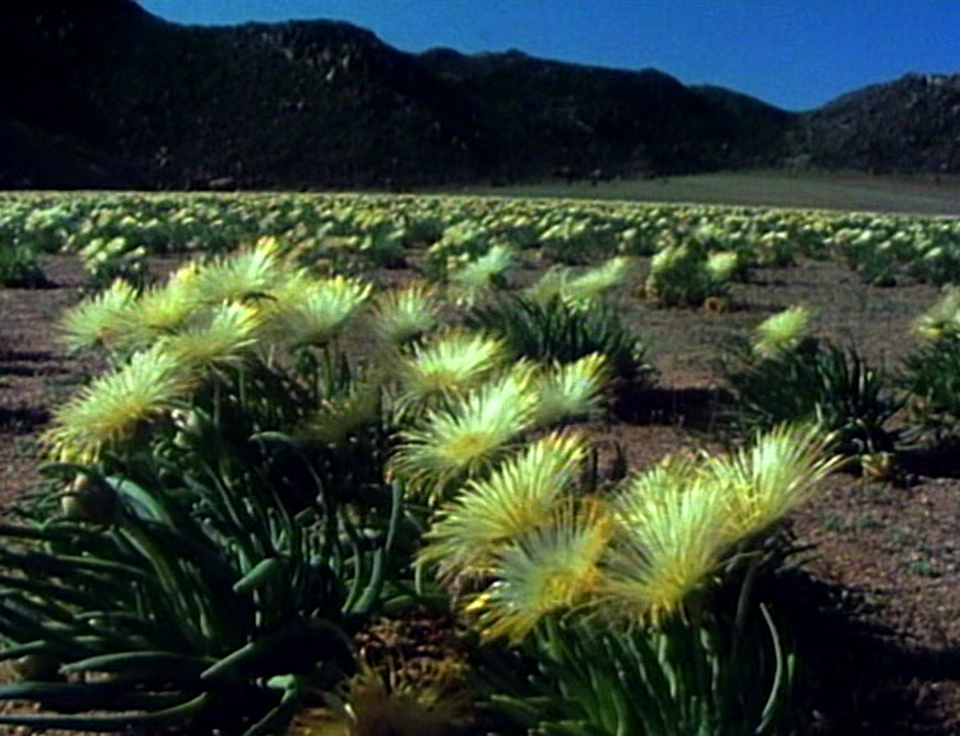BBC - The Living Planet (1984)
DVDRip | 960 x 720 | .MKV/AVC @ 1792 Kbps | 12x~56mn | 10.5 GB
Audio: English AAC 128 Kbps, 2 channels | Subs: English
Genre: Documentary, Nature
DVDRip | 960 x 720 | .MKV/AVC @ 1792 Kbps | 12x~56mn | 10.5 GB
Audio: English AAC 128 Kbps, 2 channels | Subs: English
Genre: Documentary, Nature
David Attenborough examines the ways in which animals and plants adapt to their surroundings.
Part 1: The Building of the Earth
Visits the world's deepest valley: the Kali Gandaki river in the Himalayas. Its temperatures range from those of the tropics in its lower reaches to that of the poles higher up. It therefore shows how creatures become adapted to living in certain environments.
Part 2: The Frozen World
Describes the inhospitable habitats of snow and ice. Mount Rainier in America is an example of such a place: there is no vegetation, therefore no herbivores and thus no carnivores. However, beneath its frosty surface, algae grow and some insects, such as ladybirds visit the slopes. Africa’s mountains are permanently snow-covered, and beneath peaks such as Kilimanjaro and Mount Kenya, there are communities of plants and animals.
Part 3: The Northern Forests
Begins in northern Norway, 500 kilometres north of the Arctic Circle. Here, there is only just enough light for the pine trees to survive, but it is extremely cold during the winter. Pine cone seeds provide one of the few foods available at this time of year, and large herbivores such as the moose must also rely on their fat reserves.
Part 4: Jungle
Ascends a kapok in the South American tropical rainforest to observe "the greatest proliferation of life that you can find anywhere on the surface of the Earth. There are two main causes for this: warmth and wetness. As this climate is constant, there are no seasons, so trees vary greatly in their flowering cycles.
Part 5: Seas of Grass
Explores the grasses which are present all over the world. Grass sustains huge numbers of creatures the world over, particularly in the African grasslands, where huge numbers of savannah animals have made their homes.
Part 6: The Baking Deserts
Starts in the Sahara, where the highest land temperatures have been recorded. Rock paintings depict creatures such as giraffes and antelopes, suggesting that at one point there was enough vegetation to support them.
Part 7: The Sky Above
Starts in NASA's gravity research aircraft to illustrate the effect of weightlessness. There are surprisingly many plants whose seeds are, in effect, lighter than air.
Part 8: Sweet Fresh Water
Attenborough describes the course the Amazon, starting high up in the Andes of Peru, whose streams flow into the great river. Young rivers are by nature vigorous and dangerous: they flow fast and form rapids, thick with mud and sediment.
Part 9: The Margins of the Land
Details coastal environments and the effect of tides, of which the highest can be found in the Bay of Fundy in North America. In places, erosion is causing the land to retreat, while in others — such as the tropics — the expansion of mangroves causes it to advance.
Part 10: Worlds Apart
Investigates remote islands and their inhabitants. Some islands are tips of volcanoes; others are coral atolls. Those that colonise them transform into new species with comparative speed.
Part 11: The Open Ocean
Attenborough goes underwater to observe the ocean's life forms and comment on them at first hand.
Part 12: New Worlds
Surveys those environments that have been created by and for humans.
also You can find my last: Nature-posts
General
Unique ID : 38148353658660482926619327794370960642 (0x1CB31B0CCC3C500C8C76971747F9DD02)
Complete name : BBC.The.Living.Planet.01of12.The.Building.of.the.Earth.mkv
Format : Matroska
Format version : Version 4 / Version 2
File size : 778 MiB
Duration : 56 min 35 s
Overall bit rate : 1 922 kb/s
Movie name : The Living Planet
Encoded date : UTC 2018-01-26 17:50:35
Writing application : mkvmerge v20.0.0 ('I Am The Sun') 64-bit
Writing library : libebml v1.3.5 + libmatroska v1.4.8
Video
ID : 1
Format : HEVC
Format/Info : High Efficiency Video Coding
Format profile : Main@L3.1@Main
Codec ID : V_MPEGH/ISO/HEVC
Duration : 56 min 35 s
Bit rate : 1 792 kb/s
Width : 960 pixels
Height : 720 pixels
Display aspect ratio : 4:3
Frame rate mode : Constant
Frame rate : 23.976 (24000/1001) FPS
Color space : YUV
Chroma subsampling : 4:2:0
Bit depth : 8 bits
Bits/(Pixel*Frame) : 0.108
Stream size : 725 MiB (93%)
Writing library : x265 2.6+24-69cfe46e8a3b:[Windows][GCC 7.2.0][64 bit] 8bit
Encoding settings : cpuid=1310975 / frame-threads=1 / numa-pools=2 / wpp / no-pmode / no-pme / no-psnr / no-ssim / log-level=2 / input-csp=1 / input-res=960x720 / interlace=0 / total-frames=81400 / level-idc=0 / high-tier=1 / uhd-bd=0 / ref=3 / no-allow-non-conformance / no-repeat-headers / annexb / no-aud / no-hrd / info / hash=0 / no-temporal-layers / no-open-gop / min-keyint=23 / keyint=240 / gop-lookahead=0 / bframes=5 / b-adapt=2 / b-pyramid / bframe-bias=0 / rc-lookahead=20 / lookahead-slices=4 / scenecut=40 / radl=0 / no-intra-refresh / ctu=64 / min-cu-size=8 / no-rect / no-amp / max-tu-size=32 / tu-inter-depth=1 / tu-intra-depth=1 / limit-tu=0 / rdoq-level=0 / dynamic-rd=0.00 / no-ssim-rd / signhide / no-tskip / nr-intra=0 / nr-inter=0 / no-constrained-intra / strong-intra-smoothing / max-merge=2 / limit-refs=3 / no-limit-modes / me=1 / subme=2 / merange=57 / temporal-mvp / weightp / weightb / no-analyze-src-pics / deblock=0:0 / sao / no-sao-non-deblock / rd=3 / no-early-skip / rskip / no-fast-intra / no-tskip-fast / no-cu-lossless / no-b-intra / no-splitrd-skip / rdpenalty=0 / psy-rd=2.00 / psy-rdoq=0.00 / no-rd-refine / no-lossless / cbqpoffs=0 / crqpoffs=0 / rc=crf / crf=23.0 / qcomp=0.60 / qpstep=4 / stats-write=0 / stats-read=0 / ipratio=1.40 / pbratio=1.30 / aq-mode=1 / aq-strength=1.00 / cutree / zone-count=0 / no-strict-cbr / qg-size=32 / no-rc-grain / qpmax=69 / qpmin=0 / no-const-vbv / sar=0 / overscan=0 / videoformat=5 / range=0 / colorprim=1 / transfer=1 / colormatrix=1 / chromaloc=0 / display-window=0 / max-cll=0,0 / min-luma=0 / max-luma=255 / log2-max-poc-lsb=8 / vui-timing-info / vui-hrd-info / slices=1 / no-opt-qp-pps / no-opt-ref-list-length-pps / no-multi-pass-opt-rps / scenecut-bias=0.05 / no-opt-cu-delta-qp / no-aq-motion / no-hdr / no-hdr-opt / no-dhdr10-opt / analysis-save=(null) / analysis-load=(null) / analysis-reuse-level=5 / scale-factor=0 / refine-intra=0 / refine-inter=0 / refine-mv=0 / no-limit-sao / ctu-info=0 / no-lowpass-dct / refine-mv-type=0 / copy-pic=1
Language : English
Default : Yes
Forced : No
Color range : Limited
Color primaries : BT.709
Transfer characteristics : BT.709
Matrix coefficients : BT.709
Audio
ID : 2
Format : AAC
Format/Info : Advanced Audio Codec
Format profile : LC
Codec ID : A_AAC
Duration : 56 min 35 s
Bit rate : 128 kb/s
Channel(s) : 2 channels
Channel positions : Front: L R
Sampling rate : 48.0 kHz
Frame rate : 46.875 FPS (1024 spf)
Compression mode : Lossy
Delay relative to video : 9 ms
Stream size : 51.8 MiB (7%)
Language : English
Default : Yes
Forced : No
Text
ID : 3
Format : UTF-8
Codec ID : S_TEXT/UTF8
Codec ID/Info : UTF-8 Plain Text
Duration : 54 min 42 s
Bit rate : 73 b/s
Count of elements : 521
Stream size : 29.5 KiB (0%)
Language : English
Default : No
Forced : No
Unique ID : 38148353658660482926619327794370960642 (0x1CB31B0CCC3C500C8C76971747F9DD02)
Complete name : BBC.The.Living.Planet.01of12.The.Building.of.the.Earth.mkv
Format : Matroska
Format version : Version 4 / Version 2
File size : 778 MiB
Duration : 56 min 35 s
Overall bit rate : 1 922 kb/s
Movie name : The Living Planet
Encoded date : UTC 2018-01-26 17:50:35
Writing application : mkvmerge v20.0.0 ('I Am The Sun') 64-bit
Writing library : libebml v1.3.5 + libmatroska v1.4.8
Video
ID : 1
Format : HEVC
Format/Info : High Efficiency Video Coding
Format profile : Main@L3.1@Main
Codec ID : V_MPEGH/ISO/HEVC
Duration : 56 min 35 s
Bit rate : 1 792 kb/s
Width : 960 pixels
Height : 720 pixels
Display aspect ratio : 4:3
Frame rate mode : Constant
Frame rate : 23.976 (24000/1001) FPS
Color space : YUV
Chroma subsampling : 4:2:0
Bit depth : 8 bits
Bits/(Pixel*Frame) : 0.108
Stream size : 725 MiB (93%)
Writing library : x265 2.6+24-69cfe46e8a3b:[Windows][GCC 7.2.0][64 bit] 8bit
Encoding settings : cpuid=1310975 / frame-threads=1 / numa-pools=2 / wpp / no-pmode / no-pme / no-psnr / no-ssim / log-level=2 / input-csp=1 / input-res=960x720 / interlace=0 / total-frames=81400 / level-idc=0 / high-tier=1 / uhd-bd=0 / ref=3 / no-allow-non-conformance / no-repeat-headers / annexb / no-aud / no-hrd / info / hash=0 / no-temporal-layers / no-open-gop / min-keyint=23 / keyint=240 / gop-lookahead=0 / bframes=5 / b-adapt=2 / b-pyramid / bframe-bias=0 / rc-lookahead=20 / lookahead-slices=4 / scenecut=40 / radl=0 / no-intra-refresh / ctu=64 / min-cu-size=8 / no-rect / no-amp / max-tu-size=32 / tu-inter-depth=1 / tu-intra-depth=1 / limit-tu=0 / rdoq-level=0 / dynamic-rd=0.00 / no-ssim-rd / signhide / no-tskip / nr-intra=0 / nr-inter=0 / no-constrained-intra / strong-intra-smoothing / max-merge=2 / limit-refs=3 / no-limit-modes / me=1 / subme=2 / merange=57 / temporal-mvp / weightp / weightb / no-analyze-src-pics / deblock=0:0 / sao / no-sao-non-deblock / rd=3 / no-early-skip / rskip / no-fast-intra / no-tskip-fast / no-cu-lossless / no-b-intra / no-splitrd-skip / rdpenalty=0 / psy-rd=2.00 / psy-rdoq=0.00 / no-rd-refine / no-lossless / cbqpoffs=0 / crqpoffs=0 / rc=crf / crf=23.0 / qcomp=0.60 / qpstep=4 / stats-write=0 / stats-read=0 / ipratio=1.40 / pbratio=1.30 / aq-mode=1 / aq-strength=1.00 / cutree / zone-count=0 / no-strict-cbr / qg-size=32 / no-rc-grain / qpmax=69 / qpmin=0 / no-const-vbv / sar=0 / overscan=0 / videoformat=5 / range=0 / colorprim=1 / transfer=1 / colormatrix=1 / chromaloc=0 / display-window=0 / max-cll=0,0 / min-luma=0 / max-luma=255 / log2-max-poc-lsb=8 / vui-timing-info / vui-hrd-info / slices=1 / no-opt-qp-pps / no-opt-ref-list-length-pps / no-multi-pass-opt-rps / scenecut-bias=0.05 / no-opt-cu-delta-qp / no-aq-motion / no-hdr / no-hdr-opt / no-dhdr10-opt / analysis-save=(null) / analysis-load=(null) / analysis-reuse-level=5 / scale-factor=0 / refine-intra=0 / refine-inter=0 / refine-mv=0 / no-limit-sao / ctu-info=0 / no-lowpass-dct / refine-mv-type=0 / copy-pic=1
Language : English
Default : Yes
Forced : No
Color range : Limited
Color primaries : BT.709
Transfer characteristics : BT.709
Matrix coefficients : BT.709
Audio
ID : 2
Format : AAC
Format/Info : Advanced Audio Codec
Format profile : LC
Codec ID : A_AAC
Duration : 56 min 35 s
Bit rate : 128 kb/s
Channel(s) : 2 channels
Channel positions : Front: L R
Sampling rate : 48.0 kHz
Frame rate : 46.875 FPS (1024 spf)
Compression mode : Lossy
Delay relative to video : 9 ms
Stream size : 51.8 MiB (7%)
Language : English
Default : Yes
Forced : No
Text
ID : 3
Format : UTF-8
Codec ID : S_TEXT/UTF8
Codec ID/Info : UTF-8 Plain Text
Duration : 54 min 42 s
Bit rate : 73 b/s
Count of elements : 521
Stream size : 29.5 KiB (0%)
Language : English
Default : No
Forced : No
Screenshots
Welcome to my blog - daily update!


